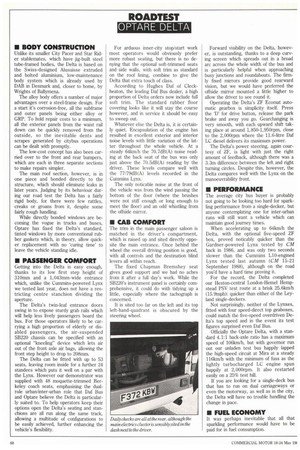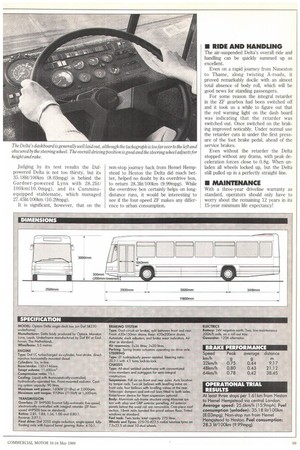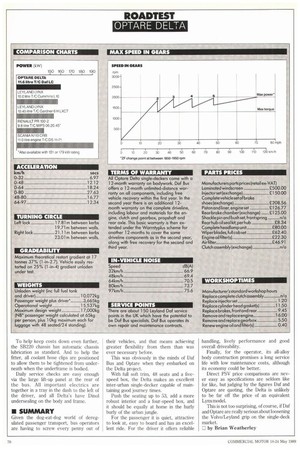• BODY CONSTRUCTION
Page 70

Page 71

Page 72

If you've noticed an error in this article please click here to report it so we can fix it.
Unlike its smaller City Pacer and Star Rider stablemates, which have jig-built steel tube-framed bodies, the Delta is based on the Swiss-designed Alusuisse extruded and bolted aluminium, low-maintenance body system which is already used by DAB in Denmark and, closer to home, by Wrights of Ballymena.
The alloy body offers a number of major advantages over a steel-frame design. For a start it's corrosion-free, all the subframe and outer panels being either alloy or GRP. To hold repair costs to a minimum, all the exterior panels from the waist rail down can be quickly removed from the outside, so the inevitable dents and scrapes generated by citybus operations can be dealt with promptly.
The low-cost concept has also been carried over to the front and rear bumpers, which are each in three separate sections to make repairs simpler.
The main roof section, however, is in one piece and bonded directly to the structure, which should eliminate leaks in later years. Judging by its behaviour during our road test the Delta has a fairly rigid body, for there were few rattles, creaks or groans from it, despite some fairly rough handling.
While directly bonded windows are becoming the vogue in trucks and buses, Optare has fixed the Delta's standard, tinted windows by more conventional rubber gaskets which, in theory, allow quicker replacement with no 'curing time' to leave the vehicle standing idle.
• PASSENGER COMFORT
Getting into the Delta is easy enough, thanks to its low first step height of 310mm and a 1,043mm-wide entrance which, unlike the Cummins-powered Lynx we tested last year, does not have a restricting centre stanchion dividing the aperture.
The Delta's twin-leaf entrance doors swing in to expose sturdy grab rails which will help less lively passengers board the bus. For those operators likely to be carrying a high proportion of elderly or disabled passengers, the air-suspended SB220 chassis can be specified with an optional "kneeling" device which lets air out of the front axle air bags, allowing the front step height to drop to 208mm.
The Delta can be fitted with up to 53 seats, leaving room inside for a further 24 standees which puts it well on a par with the Lynx. However our demonstrator was supplied with 48 moquette-trimmed Berkeley coach seats, emphasising the dualrole urban/inter-urban role that Daf Bus and Optare believe the Delta is particularly suited to. To help operators keep their options open the Delta's seating and stanchions are all run along the same track, allowing a multitude of configurations to be easily achieved, further enhancing the vehicle's flexibility. For arduous inner-city stop/start work most operators would obviously prefer more robust seating, but there is no denying that the optional soft-trimmed seats and side walls, with soft trim as standard on the roof lining, combine to give the Delta that extra touch of class.
According to Hughes Daf of Cleckheaton, the leading Daf Bus dealer, a high proportion of Delta orders now include full soft trim. The standard rubber floor covering looks like it will stay the course however, and in service it should be easy to sweep out.
Whatever else the Delta is, it is certainly quiet. Encapsulation of the engine has resulted in excellent exterior and interior noise levels with little variation of the latter throughout the whole vehicle. At a steady 64km/h the 70.7dB(A) noise reading at the back seat of the bus was only just above the 70.5dB(A) reading by the driver. These levels compare well with the 77/79dB(A) levels recorded in the Cummins Lynx.
The only noticable noise at the front of the vehicle was from the wind passing the bottom of the door (where the brushes were not stiff enough or long enough to meet the floor) and an odd whistling from the offside mirror.
• CAB COMFORT
The trim in the main passenger saloon is matched in the driver's compartment, which is raised up and sited directly opposite the main entrance. Once behind the wheel the overall driving position is good, with all controls and the destination blind levers all within reach.
The fixed Chapman Bremshey seat gives good support and we had no aches from it after a full day's work. While the SB220's instrument panel is certainly comprehensive, it could do with tidying up a little, especially where the tachograph is concerned.
It is sited too far on the left and its top left-hand-quadrant is obscured by the steering wheel. Forward visibility on the Delta, however, is outstanding, thanks to a deep curving screen which spreads out in a broad arc across the whole width of the bus and is particularly helpful when approaching busy junctions and roundabouts. The firmly fixed mirrors provide good rearward vision, but we would have preferred the offside mirror mounted a little higher to allow the driver to see round it.
Operating the Delta's ZF Ecomat automatic gearbox is simplicity itself. Press the 'D' for drive button, release the park brake and away you go. Gearchariging is very smooth, with each upward shift taking place at around 1,850-1,950rpm, close to the 2,000rprn where the 11.6-litre Daf LC diesel delivers its maximum power.
The Delta's power steering, again courtesy of ZF, is light with just the right amount of feedback, although there was a 3.3m difference between the left and right turning circles. Despite this, however, the Delta compares well with the Lynx on the manoeuvrability front.
• PERFORMANCE
The average city bus buyer is probably not going to be looking too hard for sparkling performance from a single-decker, but anyone contemplating one for inter-urban runs will still want a vehicle which can maintain good journey times.
When accelerating up to 64kinfh the Delta, with the optional five-speed ZF box, proved noticably quicker than the Gardner-powered Lynx tested by CM back in 1986, and was only two seconds slower than the Cummins L10-engined Lynx tested last autumn (CM 15-21 September 1988), although on the road you'd have a hard time proving it.
For the record, the Delta completed our Heston-central London-Hemel Hempstead PSV test route at a brisk 25.6km/h (15.9mph): quicker than either of the Leyland single-deckers.
Not surprisingly, neither of the Lynxes, fitted with four speed-direct top geaboxes, could match the five-speed overdriven Delta's top speed and in the event its test figures surprised even Daf Bus.
Officially the Optare Delta, with a standard 4.1:1 back-axle ratio has a maximum speed of 106km/h, but with governor run out our unladen test bus happily lapped the high-speed circuit at Mira at a steady 116km/h with the minimum of fuss as the lightly turbocharged LC engine spun happily at 2,000rpm. It also restarted easily on a 25% test hill.
If you are looking for a single-deck bus that has to run on dual carriageways or even the motorway, as well as in the city, the Delta will have no trouble handling the change in pace.
• FUEL ECONOMY
It was perhaps inevitable that all that sparkling performance would have to be paid for in fuel consumption. Judging by its test results the Dafpowered Delta is not too thirsty, but its 35.181it/100km (8.03mpg) is behind the Gardner-powered Lynx with 28.214/ 100km(10.0mpg), and its Cumminsequipped stablemate, which managed 27.45lit/100km (10.29mpg).
It is significant, however, that on the non-stop journey back from Hemel Hempstead to Heston the Delta did much better, helped no doubt by its overdrive box, to return 28.3lit/100km (9.99mpg). While the overdrive box certainly helps on longdistance runs, it would be interesting to see if the four-speed ZF makes any difference to urban consumption.
• RIDE AND HANDLING
The air-suspended Delta's overall ride and handling can be quickly summed up as excellent.
Even on a rapid journey from Nuneaton to Thame, along twisting A-roads, it proved remarkably docile with an almost total absence of body roll, which will be good news for standing passengers.
For some reason the integral retarder in the ZF gearbox had been switched off and it took us a while to figure out that the red warning light on the dash board was indicating that the retarder was switched out. Once switched on the braking improved noticably. Under normal use the retarder cuts in under the first pressure of the foot brake pedal, ahead of the service brakes_ Even without the retarder the Delta stopped without any drama, with peak deceleration forces close to 0.8g. When unladen all wheels locked up, but the Delta still pulled up in a perfectly straight line.
• MAINTENANCE
With a three-year driveline warranty as standard, operators should only have to worry about the remaining 12 years in its 15-year minimum life expectancy!
To help keep costs down even further, the SB220 chassis has automatic chassis lubrication as standard. And to help the fitter, all coolant hose clips are positioned to allow them to be tightened from underneath when the underframe is bodied.
Daily service checks are easy enough via the large lift-up panel at the rear of the bus. All important electrics are together in a tray in the dash to the left of the driver, and all Delta's have Dinol underseafing on the body and frame.
• SUMMARY
Given the dog-eat-dog world of deregulated passenger transport, bus operators are having to screw every penny out of their vehicles, and that means achieving greater flexibility from them than was ever necessary before.
This was obviously in the minds of Daf Bus and Optare when they embarked on the Delta project.
With full soft trim, 48 seats and a fivespeed box, the Delta makes an excellent inter-urban single-decker capable of maintaining good journey times.
Push the seating up to 53, add a more robust interior and a four-speed box, and it should be equally at home in the hurly burly of the urban jungle.
For the passenger it is quiet, attractive to look at, easy to board and has an excellent ride. For the driver it offers reliable handling, lively performance and good overall driveability.
Finally, for the operator, its all-alloy body construction promises a long service life with low maintenance costs, although its economy could be better.
Direct PSV price comparisons are never easy as specifications are seldom like for like, but judging by the figures Daf and Optare are quoting, the Delta is unlikely to be far off the price of an equivalent Lynx model.
This is not too surprising, of course, if Dal and Optare are really serious about loosening the Volvo/Leyland grip on the single-deck market.
O by Brian Weatherley
































































































































































































